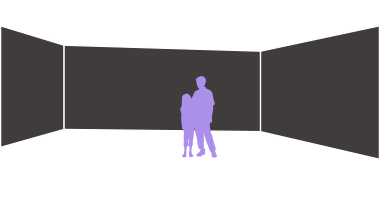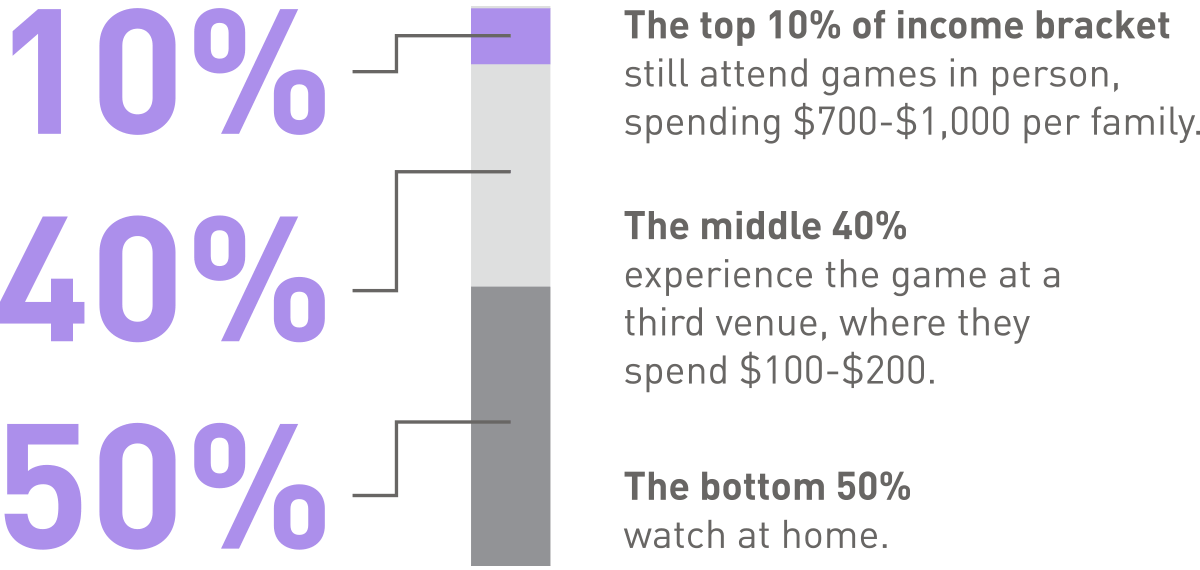“Third venues” will emerge as the go-to spaces to experience the newest and most exhilarating sports entertainment technology. Augmented reality, interactive table top technology, holographic replays, and 3-D displays will make their first public appearances in the 21st-century’s family-friendly version of sports bars. Thanks to Bitcoin and other cryptocurrencies, fans will bring real-time sports betting to third venues without traditional licensing issues. As driverless cars proliferate, alcohol consumption will triple.
-
01
Major advances in entertainment technology will initially be too expensive for widespread home-entertainment adoption.
-
02
Fans crave a shared sports experience with equally passionate fans.
Through technologies emerging today — flexible screens, motion controls, haptic — or tactile — technology, smart glasses, virtual and augmented reality — the merging of real and projected worlds will produce a seamless experience, a complete illusion. We are just starting to learn and understand how to control, manipulate and share visual and aural perceptions. The possibilities are vast.
Andrei Severny
Digital Artist and Filmmaker
-
Sports bars
-
Jumbotron simulcasts
-
Movie theater simulcasts in XD
-
Food truck parks outfitted with high-definition screens
-
Pavilions in the shadow of stadiums showing the game
The meteoric rise of e-sports will accelerate Third Venue development. This August, thousands of Dota 2 players and fans who couldn’t get tickets to The International convened to watch the tournament live at “pubstomps” in sports bars and Internet cafes across the globe.
In all likelihood, the first time you saw a widescreen HD television was in the original kind of third venue: the sports bar. Recent history suggests that breakthrough entertainment technology rarely appears in the home first. Cinema, video games, IMAX, and 3D all were launched at third venues — public spaces that are neither the home nor the stadium. The new immersive viewing technology on the horizon will also appear first in these spaces. As 360-degree video becomes more embedded in architecture, walking into the sports bar of the future will feel not just like walking into a stadium — but like walking onto the field.
What these third venues offer: the best elements of the stadium atmosphere, more creature comforts than the stadium, and fellow fans to celebrate with — the perfect integration of live and digital moments. This modular experience can be consumed a la carte to fit the personalized fan experience.
The big driver of the third venue is customer segmentation: only the top 10% income bracket of fans can routinely attend games live. The top 10% keep getting richer at a 3-5% annual rate, so ticket prices climb 3-5% consistently until they are out of reach of the rest of the fans — who watch on TV. The third venue is a way to get a family of four to spend an amount between the cost of attending the game ($500 to $1,000) and nothing (watching on TV). Perhaps at the third venue they eat and drink and get some of the feeling of having a live audience around them, while spending $60-$200, of which leagues get a cut.
Small-town moms can already go to their local movie theater to watch an Ultra HD simulcast of the Metropolitan Opera happening in New York City. Sports bar/cinema hybrids “hosting” sporting events in theater-sized venues aren’t far off. Imagine walking in and feeling just like you’re in a stadium luxury suite, watching the game through the skybox glass. Used as public and private venues, third venues allow an incredibly immersive sporting atmosphere — including the buzz of an excited crowd.
Third venues will be the first place you’ll be able to see life-sized replays up close and in fully realized 3D. The first generation of these displays won’t be true holograms (you won’t be able to view them from all sides), but they will still appear fully 3D to the viewer. Initially this technol-ogy will be used to enliven pre-and post-game interviews. As the technology advances, it will bring life-sized instant replays into sports bars and luxury lounges.
Coming Soon to a Third Venue Near You
Location-based fan competition
Apps like Spogo and BarBets already facilitate fantasy play in real time — not against anonymous strangers around the country but against other people in the same place as you. The game within the game becomes an in-person experience. As Bitcoin gains increased acceptance and usage, it will turn a third venue into something unique and interactive.

Sensory Upgrade
4DX — adds motion, smell, wind, and other sensations to watching video.

Sphere of Influence
Barco Escape — surrounds the viewer with a 270-degree view.

Family-friendly atmosphere
While bars are for adults, the third venues will transform into places where you’d really think of bringing your family, the same way Las Vegas has transformed from an adult getaway into a family tourism magnet. Whether it’s a a sliding board built into the wall, or a virtual roller coaster booth that makes youngsters shriek, innovative ways of making kids feel welcome will emerge.



